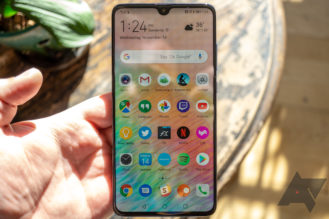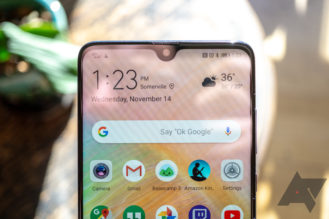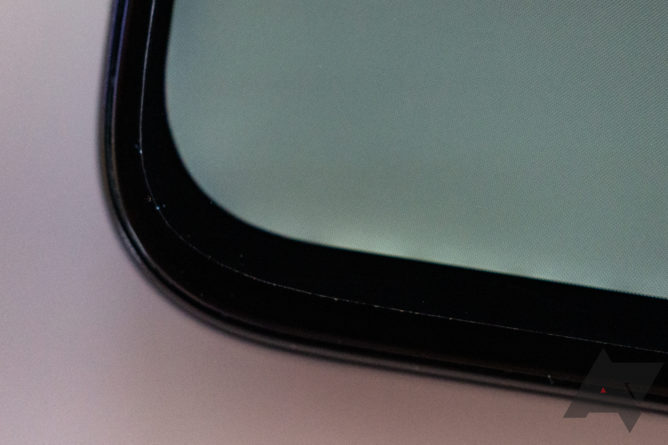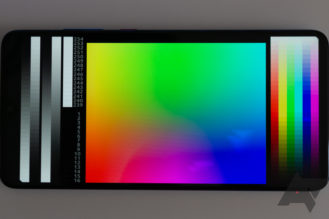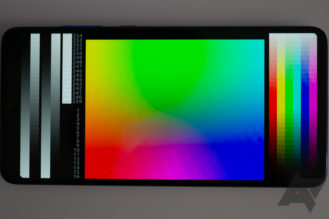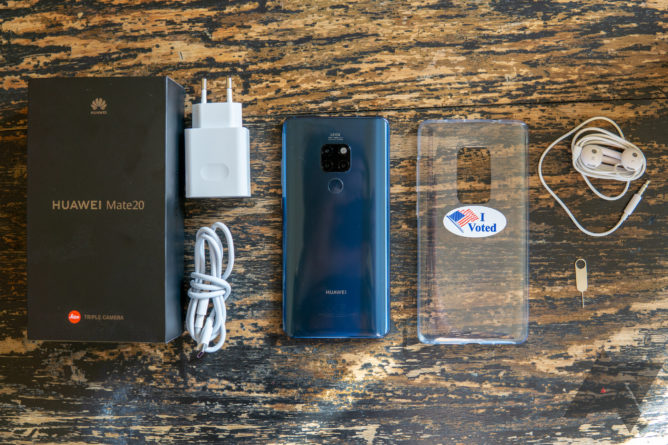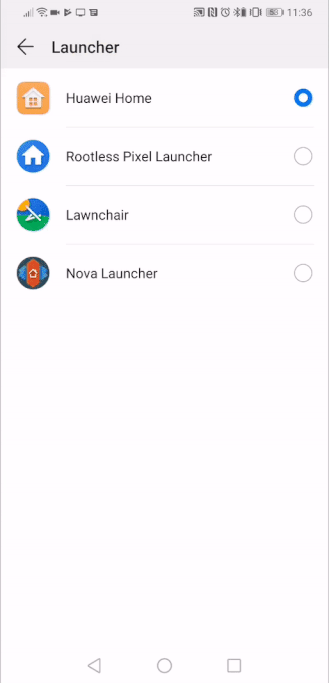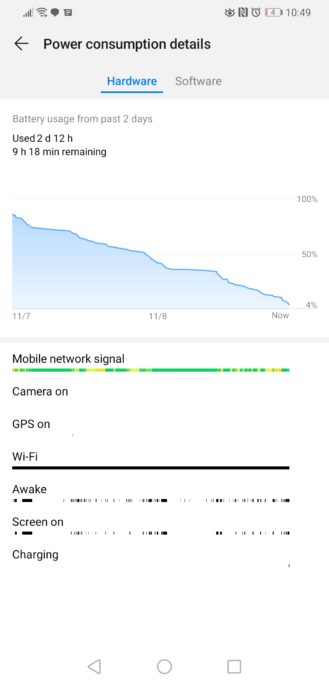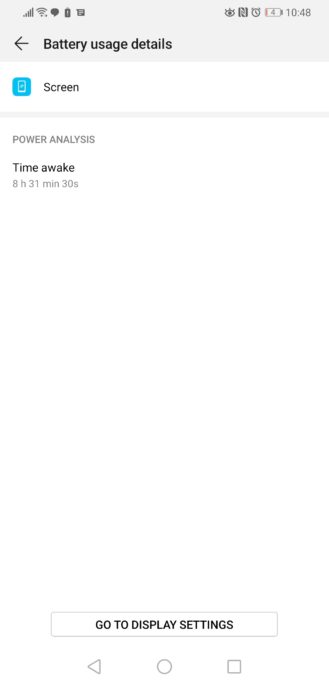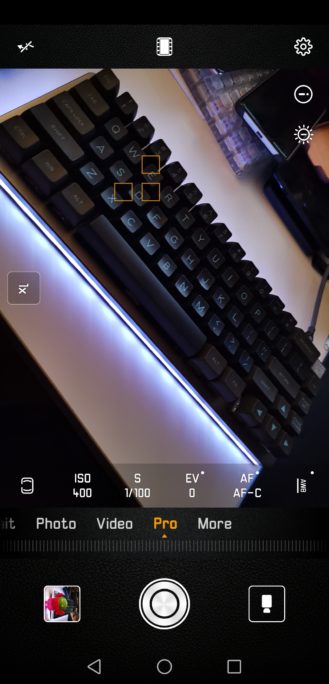Huawei’s Mate 20 Pro might take the company’s ultimate flagship title this generation, but the slightly lower-end Mate 20 is still a phone worth considering with its own strengths. It swaps a 1440p OLED display for a 1080p IPS panel, drops camera resolutions, and loses both the in-display fingerprint sensor and laser-based facial recognition. Still, for 20% less you get plenty of phone, arguably a more attractive design, and one of the best cameras in the world of Android.
Unfortunately for most of our readers, it isn’t coming to the US.
We reviewed the 6/128GB SKU in Midnight Blue, but overall performance should be similar to the 4GB model.
Design, hardware, what’s in the box
I think the Mate 20 is a gorgeous phone. While I’d have liked to see the “Twilight” two-tone color version, the textured blue glass back on the model I reviewed was still more interesting than the majority of the boring black slabs out there.
Like many 2018 flagships, it’s a glass and metal sandwich. Unlike its bigger brother, the Mate 20 Pro, the Mate 20 doesn’t have wireless charging. It’s also a bit thicker than some recent phones at 8.3mm, but I enjoyed the extra heft.
It may not be in the location I prefer, but the Mate 20 has a headphone jack up top, paired with an IR blaster. The left side is empty save the SIM tray, while the right has the volume and power buttons. At the bottom, you have the USB-C port and a downward-firing speaker, which works together with the earpiece for stereo sound, Samsung-style.
On the back, you have the three cameras together with the flash in a square configuration, raised from the glass. I’m not a fan of the look, but this isn’t the end you typically stare at. Below the camera is the fingerprint sensor — there’s no in-display solution as with the Mate 20 Pro.
The Mate 20 has a 6.53″, 2244 x 1080 IPS display with a teardrop/waterdrop notch in the same vein as the OnePlus 6T. Allegedly it can reach over 800 nits, and I had no problems using it outdoors.
Macro of the RGBW subpixel configuration on the Mate 20’s IPS panel.
381 PPI would seem to be on the low side, but it really didn’t bother me any more than the pentile artifacts on many higher-density OLED displays. That could be a result of the Mate 20 screen’s secret weapon: It has an RGBW stripe configuration for pixels. I’ve never used a phone with white subpixels before, and it’s probably a large part of why and how the screen can get so bright and seem so sharp.
It was very difficult to get a photo of what minor bleed it had.
There are recent reports of problems with the OLED display in the Mate 20 Pro, where the LG-made panel suffers a spontaneous failure after days or weeks of use, resulting in a blotchy and uneven screen. That shouldn’t be a problem with the non-pro Mate 20. The IPS display was very even, with only a bit of very minor bleed in one corner on my unit. As someone prone to be picky when it comes to screens, it was such a small defect I could easily ignore it.
Something’s wrong with how the Mate 20’s display maps color space in calibrated settings, though.
“Natural” (left) and “Vivid” (right) color calibrations. Note the strange remapping in blue and magenta on “Natural.” (Ignore the moire on the right image, it’s difficult to photograph these tests.)
I lack the right hardware to do precision testing, but the “Natural” color mode, which seems closer to sRGB-calibrated space, has some strange behavior with certain blue and purple shades. If Anandtech does a review, we’ll probably get a detailed explanation, but in the meantime it’s unfortunate.
Sticker not included.
The phone comes with the basics: A bundle of warranty/instruction pamphlets, a clear TPU case, a cheap pair of earbuds, a USB Type-C to A cable, and Huawei’s 22.5W “SuperCharge” wall-wart — EU, in my case, given the phone isn’t being sold in the US. In pure spec, that SuperCharge system should be among the fastest you can get, and it topped up my battery incredibly quickly.
Software, performance, and battery
I won’t rehash every aspect of the phone’s software since we already spoke at some length about it in our Mate 20 Pro review. I don’t find EMUI quite so reprehensible as our UK Editor Scott did, but I’m known for my software adaptability. Those coming from iOS might actually feel more at home in EMUI than stock Android, in my opinion, and I was able to accommodate its shortcomings within a week or so. While I still strongly prefer stock or stock-like, EMUI can be acceptable to the amenable.
Even so, there were still a few differences that felt like changes for the sake of change, which I couldn’t force myself to get used to. For example:
- There’s no haptic feedback when unlocking the phone.
- The double-tap power button camera shortcut uses the volume down key (and has to be enabled separately in the camera app).
- Huawei seems to have broken compatibility with most third-party launchers.
- PIN-based security forces an arbitrary six-digit length
- The software DPI is cranked so high that I can see every bit of JPEG in avatars or icons in most apps (and if you crank it down to compensate, some first-party apps look weird).
Huawei’s gesture navigation is also pretty terrible, and the constant permission dialogs for all of Huawei’s built-in crapware — some of which will feed you ads — was annoying.
Most launchers also didn’t work.
I also had some trouble with telephony via T-Mobile in the US. On more than one occasion, calls went straight through to voicemail even though I had adequate signal, and sometimes I could not hear the person on the other end of the line after answering. SMS messages were also occasionally delayed, though disabling Wi-Fi and loading something via mobile data would typically pull them down.
Performance was otherwise fantastic. I can’t remember a single dropped frame or stutter in my time with the Mate 20, with one exception: Wi-Fi performance was intermittently quite slow.
The Mate 20 is powered by Huawei’s Kirin 980, which is the first 7nm Android SoC and the first based on ARM’s A76 reference designs. I’ll skip the benchmarks (there are plenty out there if you care), but in day-to-day use, the phone was among the fastest I’ve ever used. And best of all, the battery life that went with it was exceptional.
In my regular use with Wi-Fi and Bluetooth on, two Google accounts syncing, and light social media, I was able to go 2-3 days between charges. That’s even without the benefit of an OLED display or dark themes. Coming from the OnePlus 6T, which already had pretty great battery life, the Mate 20’s longevity was stunning.
Huawei’s silicon continues to be magical.
Camera
A lot of people are saying the Mate 20 and Mate 20 Pro may have a better camera than Google’s Pixels. That’s a matter of taste, but in many circumstances, I agree.
Left: Mate 20, Right: Pixel3.
It didn’t always win in my own comparisons, but the Mate 20 pulls some exceptional detail in challenging lighting conditions where the Pixel 3 can’t. Sometimes its colors are also a bit closer to reality. Like the Pixels, (and unlike some other phones) images aren’t mangled into an oily mess on a crop. Huawei is able to sharpen without oversharpening, preserving detail.
Left: 1x zoom/27mm, Middle: 2x zoom/52mm, Right: 10x software-assisted zoom.
Having three different focal lengths/zooms available was also nice for those times when you just can’t get any closer, and you don’t want to deal with how crappy digital zoom always looks.
Left: Pixel 3 Super Res Zoom, Right: Mate 20 10x zoom.
That said, I think Google may have an edge with its “Super Res Zoom.” To be fair, both software zoom results are a muddy mess, but the Pixel 3 pulls out a few more details than the Mate 20, though the Mate 20 has a stronger zoom in the end.
The Mate 20’s biggest strengths come out if you flip the camera app over into “Pro” mode, where you can have full manual control over everything from ISO to exposure and even manual focus. If you’re a DSLR-toting shutterbug, it’s pretty sweet.
My biggest complaint was that if you plan on using the auto “Photo” mode, results can vary wildly between shots. While the Pixel 3 will give you around the same results every time, the Mate 20 tended to choose drastically different settings for exposure and white balance less than a second apart.
On average, I still prefer the results of Google’s photo processing on the Pixels, but the Mate 20’s camera is easily on the same level. And with the added benefit of three different focal lengths and manual controls, the Mate 20 provides extra utility the Pixel 3 and 3 XL just can’t.
Should you buy it?
Yes, but the Mate 20 is not for everyone. Huawei’s software will bother those accustomed to stock Android — or even most other OEM ROMs like the Samsung Experience. I hate to harp on the “non-stock = bad” stereotype, but Huawei’s changes to Android are heavy-handed, without a consistent or thoughtful approach, and at the expense of functionality in some cases. The software here is an explicit compromise, albeit one you can get used to, and which could be outright beneficial if you’re coming from iOS.
There are other aspects where Huawei’s non-pro flagship beats the competition soundly. The Mate 20 has some of the most beautiful hardware I’ve ever seen in a phone, period. This is the first IPS-equipped Android device I’ve used with no chin — or rather, a chin so small and symmetrical as to lose the name. Apart from the wonky calibration, I absolutely loved the screen, and the industrial design is among the very best you’ll find in an Android phone.
Paired with a fantastic triple-camera setup, the Mate 20 (and by extension, the Mate 20 Pro) is one of the best Android phones out there right now, but only if you’re willing to accept Huawei’s myopic software vision.
Buy it if:
- A more flexible phone camera is a priority.
- You’re outside the US.
- The software experience isn’t a major concern.
Don’t buy it if:
- You’re in the US.
- Software is important, and you prefer stock Android (or at least more control).
- The 800€ starting price is too high for you.
Where to buy:
UK (only available on contract) – Affordable Mobiles, Buymobiles.net, GoMobile
Germany – €799 – Amazon.de
France – €799 – Amazon.fr, Fnac
Spain – €799 – Fnac.es, El Corte Inglés



